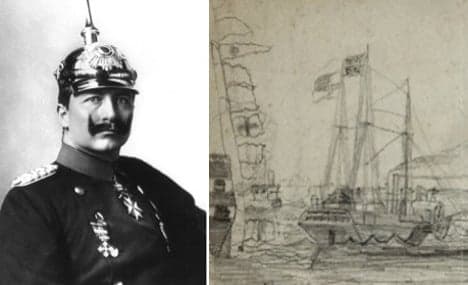Kaiser's early love of sea surfaces in sketches

Wilhelm II was usually portrayed in heavily decorated army uniform, but the last Kaiser's heart yearned for the sea and German naval power from an early age, a series of newly discovered childhood drawings shows.
Five sketches donated to a Brandenburg museum depict scenes ranging from a matchstick sailor to full-blown naval engagements between steamships and coastal emplacements imagined by the 14-year-old future monarch.
Yet at the time, Germany's meager sea forces were generally assigned to coastguard work.
"His favourite theme even in early childhood was the navy," said Stephan Theilig, director of the Brandenburg-Preußen Museum in Wustrau outside Berlin, which received the drawings from an anonymous donor.
Authenticated by experts, the five A4-sized sketches drawn when Wilhem was aged six to 14 came from the estate of his former tutor. In time, the crown prince became more skilled in his use of detail such as foaming wave crests and smokestack trails on the ships, added Theilig.
CLICK HERE to see some of the drawings
Wilhelm, who became Kaiser in 1888, reputedly began honing his naval ambitions after reading the 1890 work of US Admiral Alfred Mahan "The influence of sea power upon history".
The Kaiser then envisaged the development of Germany's navy into a strong and natural ally for Great Britain on the high seas, a plausible scenario given that he was Queen Victoria's grandson.
The outbreak of World War I scotched this hope and as the war ground on, the German military command increasingly sidelined the Kaiser in its decision-making.
Although Germany's submarines waged a fierce campaign against Allied shipping, its surface ships were largely confined to port. Far from the navy turning the war in the country's favour, subsequent crew mutinies contributed heavily to Germany's World War I defeat. The bulk of the German fleet was scuttled in Scapa Flow in Scotland in 1919.
Wilhelm abdicated in November 1918 and fled to the Netherlands where he lived until his death in 1941 without setting to sea again.
Today, the five sketches offer a valuable insight into the young future Kaiser's thinking, said museum director Theilig: "These drawings will allow us to complete our collection."
SEE ALSO: The WWI photo album of a German soldier
Comments
See Also
Five sketches donated to a Brandenburg museum depict scenes ranging from a matchstick sailor to full-blown naval engagements between steamships and coastal emplacements imagined by the 14-year-old future monarch.
Yet at the time, Germany's meager sea forces were generally assigned to coastguard work.
"His favourite theme even in early childhood was the navy," said Stephan Theilig, director of the Brandenburg-Preußen Museum in Wustrau outside Berlin, which received the drawings from an anonymous donor.
Authenticated by experts, the five A4-sized sketches drawn when Wilhem was aged six to 14 came from the estate of his former tutor. In time, the crown prince became more skilled in his use of detail such as foaming wave crests and smokestack trails on the ships, added Theilig.
CLICK HERE to see some of the drawings
Wilhelm, who became Kaiser in 1888, reputedly began honing his naval ambitions after reading the 1890 work of US Admiral Alfred Mahan "The influence of sea power upon history".
The Kaiser then envisaged the development of Germany's navy into a strong and natural ally for Great Britain on the high seas, a plausible scenario given that he was Queen Victoria's grandson.
The outbreak of World War I scotched this hope and as the war ground on, the German military command increasingly sidelined the Kaiser in its decision-making.
Although Germany's submarines waged a fierce campaign against Allied shipping, its surface ships were largely confined to port. Far from the navy turning the war in the country's favour, subsequent crew mutinies contributed heavily to Germany's World War I defeat. The bulk of the German fleet was scuttled in Scapa Flow in Scotland in 1919.
Wilhelm abdicated in November 1918 and fled to the Netherlands where he lived until his death in 1941 without setting to sea again.
Today, the five sketches offer a valuable insight into the young future Kaiser's thinking, said museum director Theilig: "These drawings will allow us to complete our collection."
SEE ALSO: The WWI photo album of a German soldier
_im_alter_von_14_jahren.jpg)
Join the conversation in our comments section below. Share your own views and experience and if you have a question or suggestion for our journalists then email us at [email protected].
Please keep comments civil, constructive and on topic – and make sure to read our terms of use before getting involved.
Please log in here to leave a comment.